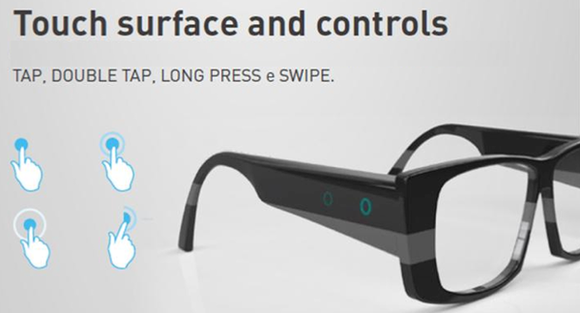
According to Francesco Giartosio, GlassUps’ chief executive, one of the chief differences between Google Glass and the GlassUp eyewear will be in how the device displays data; instead of projecting information onto the edge of the glass from an offset projector, GlassUp will use a dedicated lens embedded in the glass itself.
That will allows GlassUp to overlay monochromatic text directly “ahead” of the user’s eye, which Giartosio said was more ergonomic. GlassUp’s display has a resolution of 320 by 240 pixels.

.
GlassUp is just one of a number of companies vying to be the next big thing in “wearable computing,” with the argument being that consumers will eventually grow too lazy to haul their smartphone out of their pocket. Instead, a number of Google Glass competitors have developed wrist-mounted devices including the Pebble or the rumored Apple iWatch to provide glanceable information.
But while Glass is a standalone device, GlassUp characterizes its glasses as “basically a second screen output for your devices,” that connect via Bluetooth to your phone or tablet.
As such, it will be “read only,” only able to receive information—unlike Glass, which can be used to send information back and forth. GlassUp will also forego voice input—something that will arrive in a future generation, according to Giartosio—and there won’t be a camera included for recording photos and video, either. However, sensors including an accelerometer, compass, ambient light sensor, and a precision altimeter are included.
The GlassUp glasses include a touchpad on the right side of the eyewear, which GlassUp says will support gestures such as swiping, as a means to avoid tapping on your phone all the time.

The company envisions GlassUp projecting messages, tweets, and real-time directions on the screen, overlaying the “real world” that’s visible though the glasses. However, it’s difficult to see how apps that showed real-time translations of movies would work with GlassUp, as it lacks both a camera and audio sensors.
However, while Google has refined its industrial design, Giartosio says that GlassUp is located in northern Italy—right smack in the middle of eyeglass designers like Luxottica, Safilo, Marcolin, De Rigo, who design eyeglass brands like Ray-Ban, Oakley and others. The company will develop two models, a basic and a “sporty” model.
No comments:
Post a Comment